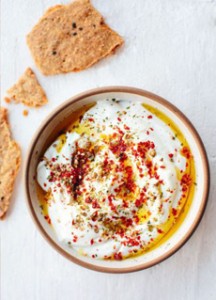TIP OF THE DAY: Make Labneh, Lebanese Yogurt Cheese
 The trick to plating labneh or yogurt dip: Use a shallow bowl or a plate and add the labneh. You can make a depression in the middle with a soup spoon and fill it with extra virgin olive oil, or drizzle the olive oil on top and around the edges. Then, sprinkle the entire surface with herbs and spices: chopped fresh mint leaves or thyme, paprika, sumac or za’atar. You can also garnish with Kalamata olives, ideally pitted. |
If you made the farmer cheese recipe we published last weekend, you probably had a lot of fun. So here’s cheese-making, part 2: Make labneh today, enjoy it this weekend. Prep time is just five minutes, plus 1-2 days to let the cheese drain. All you do is place Greek yogurt in a sieve (strainer or colander) lined with cheesecloth or paper towels, place the sieve over a bowl in the fridge and let the moisture (the whey) drain out. Once the whey is removed, the firm solids that remain (the curds) are called cheese. This is common to all cheese making, from fresh cheeses like cottage cheesed to aged cheeses, where the curds are pressed into a mold to age. Bonus: Labneh is low in calories, 40 per ounce when made with whole milk yogurt. And since the yogurt is not heated after incubation, the active yogurt cultures remain live. WHAT IS LABNEH? Labneh or labne (pronounced LOB-neh or LOB-nay) is a thick, creamy, tangy fresh cheese, often called “yogurt cheese” in the U.S. Thicker than Greek yogurt, it’s considered the Lebanese version of cream cheese. Labneh is packed with live cultures (beneficial bacteria), calcium and protein. It isn’t made with vegetable gum and shaped into a brick like American cream cheese. Rather, it’s sold in a container the size of a large yogurt. A mainstay for breakfast and snacking in the Middle East, labneh is available in grocery stores here. But since it’s so easy to make, why not have the fun of making your own? |
|
|
USES FOR LABNEH
RECIPE: HOMEMADE LABNEH (YOGURT CHEESE) While the recipe for labneh couldn’t be more basic, we thank Good Eggs of San Francisco for inspiring this article. Note that straining yogurt can reduce the volume of the yogurt by 50% or more, depending on how long you strain it (how thick the finished cheese is). Save the drained liquid (the whey). It’s filled with nutrients and we enjoy drinking it, but it can be used as a milk substitute in many ways, including mac and cheese. Ingredients For 2 Cups |
||
|
For Serving
1. MIX the salt and yogurt. Line a bowl or plate with 3 layers of cheesecloth and add the yogurt. If you don’t have cheesecloth, you just place the yogurt in a sieve/strainer or colander. At this point, you can mix in herbs and spices, or use them as garnishes to the finished cheese. 2. GATHER the edges of the cheesecloth around the yogurt and tie them with a string. Or, place the strainer over a bowl to catch the whey, and place it in the fridge. If you don’t have space in the fridge, in the cool weather you can use a cool spot in your home to let the yogurt drain; but you’ll want to wrap it in cheesecloth. 3. LET STRAIN for 1-2 days, or until labneh reaches the desired consistency. |
 The joy of cheese making. Photo courtesy Good Eggs | San Francisco. |
|
|
WHAT IS SUMAC? Sumac is ground from a red berry-like drupe that grows in clusters on bushes in subtropical and temperate regions. The dried drupes of some species are ground to produce a tangy, crimson spice. (One of the species not used is the poison sumac shrub.) The word “sumac” comes from the old Syriac Aramaic summaq, meaning red. In Middle Eastern cuisine, the spice is used to add a tangy, lemony taste to meats and salads; and to garnish hummus and rice. The spice is also a component of the popular spice blend, za’atar, below. An easy substitute for sumac: lemon zest plus salt. (In salads, use lemon juice or vinegar.) Also spelled zahtar, za’atar is a spice blend that is very popular in Middle Eastern cuisines. It is actually the word for Lebanese oregano, a member of the mint family Lamiaceaea, and known since antiquity as hyssop. The za’atar blend includes spices well-known in European cuisines, with the unique components of Lebanese oregano and sumac berries, which impart a tart, fruity flavor that differentiates za’atar from other spice blends. Traditional ingredients include marjoram, oregano, thyme, toasted sesame seeds, savory and sumac. Za’atar is used to season meat and vegetables, mixed with olive oil and spread on pita wedges or flatbread, added to hummus, and for a modern touch, sprinkled on pizza, especially ones with feta cheese. Fresh cheese is a category of unaged cheeses with a high moisture content (whey). They are typically set by adding lactic acid cultures. The cheeses can be made from any type of milk. Uncomplicated in flavor, fresh cheeses have a creamy, soft texture and fresh, sweet flavor. They are often used in cooking and with fruit for dessert. Fresh cheeses include cottage cheese, cream cheese, crème fraîche, fromage blanc, mascarpone, Neufchâtel, panir, ricotta, queso blanco, queso fresco and quark. Fresh cheeses are not made to age, and should be consumed quickly. Here’s more about fresh cheeses. |
||


